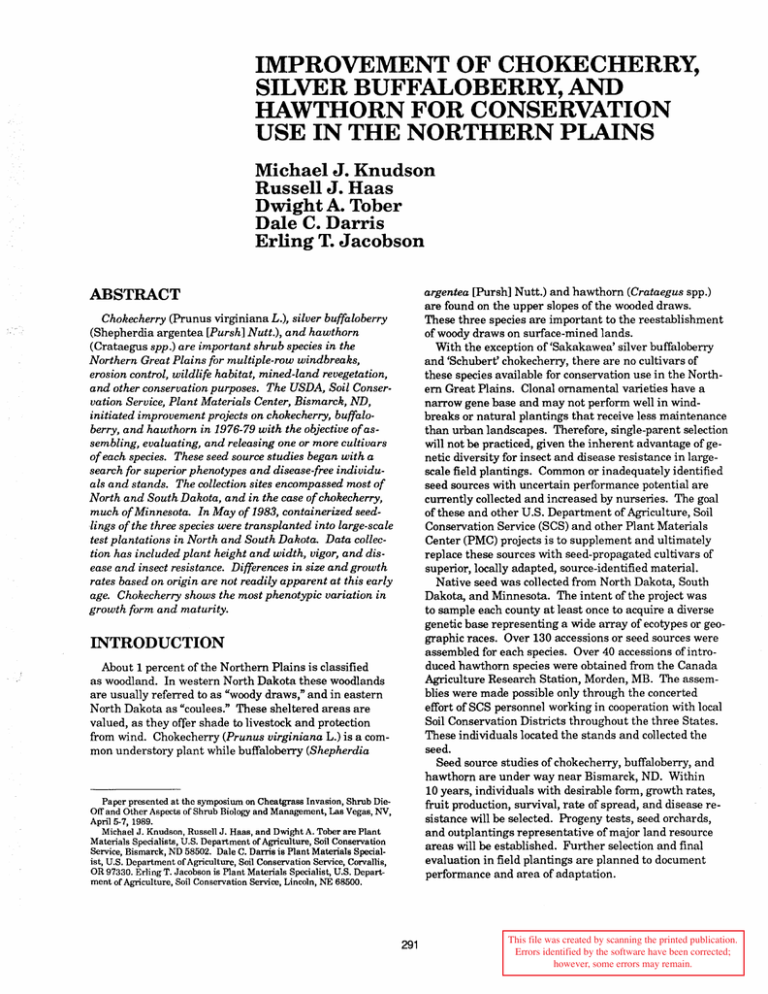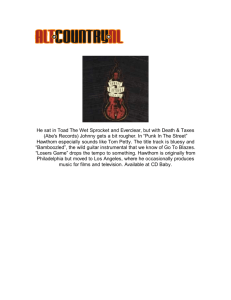IMPROVEMENT OF CHOKECHERRY, SILVER BUFFALO BERRY, AND HAWTHORN FOR CONSERVATION
advertisement

IMPROVEMENT OF CHOKECHERRY, SILVER BUFFALOBERRY, AND HAWTHORN FOR CONSERVATION USE IN THE NORTHERN PLAINS Michael J. Knudson Russell J. Haas Dwight A. Tober Dale C. Darris Erling T. Jacobson argentea [Pursh] Nutt.) and hawthorn (Crataegus spp.) are found on the upper slopes of the wooded draws. These three species are important to the reestablishment of woody draws on surface-mined lands. With the exception of'Sakakawea' silver buffaloberry and 'Schubert' chokecherry, there are no cultivars of these species available for conservation use in the Northern Great Plains. Clonal ornamental varieties have a narrow gene base and may not perform well in windbreaks or natural plantings that receive less maintenance than urban landscapes. Therefore, single-parent selection will not be practiced, given the inherent advantage of genetic diversity for insect and disease resistance in largescale field plantings. Common or inadequately identified seed sources with uncertain performance potential are currently collected and increased by nurseries. The goal of these and other U.S. Department of Agriculture, Soil Conservation Service (SCS) and other Plant Materials Center (PMC) projects is to supplement and ultimately replace these sources with seed-propagated cultivars of superior, locally adapted, source-identified material. Native seed was collected from North Dakota, South Dakota, and Minnesota. The intent of the project was to sample each county at least once to acquire a diverse genetic base representing a wide array of ecotypes or geographic races. Over 130 accessions or seed sources were assembled for each species. Over 40 accessions of introduced hawthorn species were obtained from the Canada Agriculture Research Station, Morden, MB. The assemblies were made possible only through the concerted effort of SCS personnel working in cooperation with local Soil Conservation Districts throughout the three States. These individuals located the stands and collected the seed. Seed source studies of chokecherry, buffaloberry, and hawthorn are under way near Bismarck, ND. Within 10 years, individuals with desirable form, growth rates, fruit production, survival, rate of spread, and disease resistance will be selected. Progeny tests, seed orchards, and outplantings representative of major land resource areas will be established. Further selection and final evaluation in field plantings are planned to document performance and area of adaptation. ABSTRACT Chokecherry (Prunus virginiana L.), silver buffaloberry (Shepherdia argentea [Pursh] Nutt.), and hawthorn (Crataegus spp.) are important shrub species in the Northern Great Plains for multiple-row windbreaks, erosion control, wildlife habitat, mined-land revegetation, and other conservation purposes. The USDA, Soil Conservation Service, Plant Materials Center, Bismarck, ND, initiated improvement projects on chokecherry, buffaloberry, and hawthorn in 1976-79 with the objective of assembling, evaluating, and releasing one or more cultivars of each species. These seed source studies began with a search for superior phenotypes and disease-free individuals and stands. The collection sites encompassed most of North and South Dakota, and in the case of chokecherry, much of Minnesota. In May of 1983, containerized seedlings of the three species were transplanted into large-scale test plantations in North and South Dakota. Data collection has included plant height and width, vigor, and disease and insect resistance. Differences in size and growth rates based on origin are not readily apparent at this early age. Chokecherry shows the most phenotypic variation in growth form and maturity. INTRODUCTION About 1 percent of the Northern Plains is classified as woodland. In western North Dakota these woodlands are usually referred to as "woody draws," and in eastern North Dakota as "coulees." These sheltered areas are valued, as they offer shade to livestock and protection from wind. Chokecherry (Prunus virginiana L.) is a common understory plant while buffaloberry (Shepherdia Paper presented at the symposium on Cheatgrass Invasion, Shrub DieOff and Other Aspects of Shrub Biology and Management, Las Vegas, NV, April 5-7, 1989. Michael J. Knudson, Russell J. Haas, and Dwight A. Tober are Plant Materials Specialists, U.S. Department of Agriculture, Soil Conservation Service, Bismarck, ND 58502. Dale C. Darris is Plant Materials Specialist, U.S. Department of Agriculture, Soil Conservation Service, Corvallis, OR 97330. Erling T. Jacobson is Plant Materials Specialist, U.S. Department of Agriculture, Soil Conservation Service, Lincoln, NE 68500. 291 This file was created by scanning the printed publication. Errors identified by the software have been corrected; however, some errors may remain. CHOKECHERRY Over 70 species of game and songbirds along with several small mammals utilize the fruits or buds (Vilkitis 1974). Chokecherry has potential for surface-mine reclamation (Thornburg 1982) and the revegetation of depleted game ranges (Dietz and others 1980). The stems of chokecherry show an increase in protein from fall to winter, which makes it desirable to deer (Dietz 1972). Studies are under way to select ecotypes with improved seedling vigor, palatability, and productivity in the Intermountain region (Monsen and Davis 1985). It is recommended for the outer row ofmultirow windbreaks, single and twin row dense barriers, and wildlife plantings in the Dakotas (Tree Planting Handbook for the Dakotas 1976). A colorful horticultural variety widely available in the Northern Plains is the red-leaved 'Schubert' chokecherry. When seed-propagated, this cultivar has been used for conservation plantings, but common material is generally increased for these purposes. Chokecherry is one of the most widely distributed native tall shrubs or small trees in North America (Vilkitis 1974). It occurs from Newfoundland south to Georgia and west to California and British Columbia. In the North Central Plains its habitat includes moist sites in open areas, along fencerows, roadsides, and borders of woods as well as sandy or rocky hillsides and ravines (Stephens 1973). Three varieties have been described: var. virginiana in the Eastern United States, var. melanocarpa in the West, and var. demissa along the Pacific Coast (Little 1979). Some forms have yellow rather than dark red or black fruit. The leaves ofvar. melanocarpa are thicker and cordate rather than oval, oblong, or obovate as in var. virginiana. The fruit is less astringent (Sargent 1965). The leaves and bark are very bitter. The leaves contain prussic acid, and when withered are poisonous to cattle (Gibson 1913). Adaptive characteristics of chokecherry include fast growth, dependable fruit crops, tolerance to harsh climatic extremes, and the ability to grow on a wide variety of soil types (Vilkitis 1974; Mulligan and Munro 1981). A dominant shrub species in several major woodland habitat types of the Northern Plains (Bjugstad and Girard 1984), it is browsed by deer (Odocoileus sp.) and other big game animals. It spreads by underground stems, forming clumps and thickets that provide wildlife food and cover. Insects and Diseases Chokecherry is host to a number of insects and diseases. Therefore, selection ofless susceptible individuals or sources is a major objective of this project. Common insect pests in the Northern Plains are listed by Stein and Kennedy (1976, 1972; table 1). Some, like the tent caterpillars (Malacosoma sp.), uglynest caterpillar (Arckips cerasivoranus), and fall webworm Table 1-Common insects found on trees and shrubs in North and South Dakota (Stein 1976) Tree species Insect species Borers Leaf feeders COMMON CHOKECHERRY A/sophi/a pometaria Chaetophlocus heterodoxus Prunus virginiana (fall cankerworm) (a bark beetle) Archips cerasivoranus C/ytophorus verrucosus (uglynest caterpillar) (a roundheaded wood borer) Hyphantria cunea Ropalopus sanguinicol/is (fall webworm) (a roundheaded wood borer) Ma/acosoma californicum /utescens (prairie tent caterpillar) SILVER BUFFALOBERRY Shepherdia argentea Datana sp. (a caterpillar) Erannis tiliaria (linden looper) ARNOLD HAWTHORN Crataegus arno/diana Acrobasis indiginella (a leaf crumpler) Antheraea polyphemus (polyphemus moth) Caliroa cerasi (pearslug) Hyalophora cecropia Sucking insects Asiphonaphis pruni (a plum aphid) Contarinia virginianiae (chokecherry midge) Gyponana flavilineata (a leafhopper) Rhopalosiphum cerasifoliae (chokecherry aphid) Tortistilus inermis (a treehopper) Paratrioza arborensis (a psyllid) Psylla magnicauda (a psyllid) Saperda candida (roundheaded apple tree borer) Xy/otrechus convergens (a roundheaded wood borer) 292 Chaitophorus populico/a (aphid) Corythucha cydoniae (hawthorn lace bug) Eriosoma lanigerum (woolly apple aphid) Rhopalosiphum fitchii (aphid) Telomona tristis (treehopper) (Hyphantria cunea) are often more unsightly than destructive. Defoliation caused by fall cankerworm (Alsophila pometaria) can be a problem. A more detailed list of insects is provided by Quist (1980). Leaf spots such as bacterial spot (Xanthomonas pruni) and shothole (Coccomyces lutescens) are prevalent. Also reported are several decay fungi and a stem canker (Valsa leucostoma). Two more-troublesome diseases are black knot (Dibotryon morbossum) and the leafhoppertransmitted Western-X disease caused by a mycoplasma. Black knot infections, noted for their black, hard, elongate swellings on stems, can girdle and kill infected branches (Lamey and Stack 1980). Western-X, widely distributed throughout the area, has also been a deterrent to planting chokecherry (Hoag 1965; Peterson 1966). Foliage becomes prematurely yellow and red, plants become stunted, and rapid spread can cause severe mortality (Peterson 1984). were sampled by SCS personnel stationed in local Soil Conservation District offices throughout the study area of North Dakota, South Dakota, and Minnesota. These individuals were instrumental in locating potentially superior stands and collecting the seed. One or more parents were sampled at each site. Fruit was received by the Bismarck Plant Materials Center and macerated to separate seed from the pulp. Each seed lot was cold stratified at 41 °F for 150 days, germinated in plastic trays, then transplanted into "styrobloc" containers in the spring of 1980 and 1981. Stock was grown in a lathhouse under sprinkler irrigation and fertilization. In April-May of 1983, 3,100 seedlings were hand planted at two field locations. One plantation is located on U.S. Fish and Wildlife Service land approximately 5 miles east of Bismarck in Burleigh County, ND. Of the original179 accessions, 160 were established. Figure 1 illustrates the sample site distribution by county for surviving accessions. Experimental design is a randomized block with some blocks incomplete. Accessions are replicated five times with four trees per replication. An additional outer row is used to Assembly and Evaluation The assembly of chokecherry was initiated and completed in 1979. A total of 179 native sites (accessions) I\J] 1 Site/County ~ 2-3 Sites/County Figure 1-Sample sites for chokecherry collections. Of the 160 sites, 41 were in North Dakota, 38 in South Dakota, 79 in Minnesota, and two outside these States. 293 cedrorum) in the fall (Looman 1984). Evans and Dietz (197 4) reported that among seven woody species tested, its fruit provided the best nutrition for sharp-tailed grouse (Pediocetes phasianellus) in winter. The fruit makes excellent jelly. As an actinorhizal pioneer species, buffaloberry is an important and widely propagated plant for land reclamation and amenity plantings in the United States and Canada (Fessenden 1979). This hardy species has long been recognized for its successful use as a shrub row in shelterbelts of the Northern Plains (Johnson 1928; Olson and Stoeckeler 1935). offset border effects. A second plantation comprised of similar accessions was established the same year in Sully County, SD. The property is managed by the South Dakota Game, Fish, and Parks Department. Test plantations are maintained under clean cultivation. Weeds are controlled by within-row tree cultivators and hand hoeing. The herbicide Simazine was applied to the South Dakota planting in 1985, 1987, and 1988. Each year a cover crop is seeded for erosion control at the North Dakota and South Dakota sites. Animal damage has been minimal at the North Dakota site, but more severe in South Dakota. Repellents were applied the year of establishment. Defoliating insects can be numerous in some years. To reduce growth suppression at the North Dakota planting, infestations of fall webworm were sprayed with insecticide in 1984 and 1985. In 1987 the trees were sprayed for control of the uglynest caterpillar. The cecropia moth caterpillar (Hyalophora cecropia) caused significant damage to 7 percent of the trees in 1985. Leaf spot was prevalent throughout the plantation. A few individuals already express symptoms of black knot. In 1987 a few trees showed some symptoms ofWestern-X disease, but in 1988 there was no evidence of the disease. For the first four growing seasons, performance data have included survival, height, and canopy width. In 1985 (North Dakota only), visual comparison ratings were recorded for plant vigor and rate of spread. Both multiple- and single-stem types are apparent. About 8 percent of the plants showed very little suckering, while 2 percent showed a very high rate of spread. The remaining 90 percent were what is typical for chokecherry. Early growth rates are highly variable, ranging from 13 to 28 inches/yr. Survival in 1985 totaled 95 percent. In 1988 some of the trees were as tall as 13-14 ft. Survival at the South Dakota plantation is 56 percent, partly a result of poor establishment and droughty conditions the past two growing seasons. Insects and Diseases Insect problems are generally not severe. However, psyllids (Psyllidae) are frequently reported. Common leaf feeding and sucking insects in the Dakotas are listed by Stein (1976; table 1). Looman (1984) found the larvae of June beetle (Phyllophaga spp.) and click beetle (Elateridae) feeding on the roots. The disease white heart rot (Fomes ellisianus) is species specific and widespread. The decay organism infects maturing stands, rendering them weak and susceptible to wind damage. A fungal canker (Cucurbitaria sp.) infects younger plants. Also present in the plains is a leaf spot (Cylindrosporium sp.) (Peterson 1967). 'Sakakawea' is the only variety available for conservation use in the Northern Plains. It is a selection from the Canadian cultivar 'Goldeye,' which was released in 1983 by the SCS in cooperation with the Agricultural Experiment Stations of Minnesota, North Dakota, and South Dakota (USDA SCS 1985). This seed-propagated cultivar is recognized for its good to excellent survival, seed production, and uniformity. Twelve to 20 percent of the offspring express a trait for yellow fruit. The selection serves as an interim release. Further improvement of growth rate, form, branch angle, disease resistance, or other traits should be possible because of the species' broad range and ecotypic variation. SILVER BUFFALOBERRY Silver buffaloberry is a native, thorny thicket forming a large shrub or small tree, well adapted to the cold temperatures and semiarid climate of the Northern Plains. While its geographical distribution is centered in the Dakotas, Montana, and southern regions of the Canadian Prairie Provinces, it can be found scattered from the Central Plains west to Oregon and California (Elias 1980). Habitat ihcludes moderate-textured soils in prairie valleys, along streambanks, or on steep, eroded hillsides (Stephens 1973). An excellent account of the species and its ecology is provided by Looman (1984). Often forming single-clone patches and nearly impenetrable clumps, silver buffaloberry is an important source of cover and food for small and large game animals (Hladek 1971). Despite the sharp thorns, domestic cattle and mule deer (Odocoileus hemionus) browse young shoots and eat the red berries. Cottontails (Sylvilagus nuttallii) and jackrabbits (Lepus townsendii) browse new shoots and eat the stems and bark in winter. The abundant fruit is food for cedar waxwings (Bombycilla Assembly and Evaluation The silver buffaloberry assembly was initiated in 1977 and completed in 1979 with the assistance of SCS field personnel. One hundred thirty-four sites were sampled in North and South Dakota. Seed was collected from one or more parents at each location. An additional four seed lots were obtained from Agriculture Canada Research Branch, Morden, MB. From the original collection, 101 accessions are represented in the test plantation near Bismarck. Figure 2 illustrates the geographic distribution of sources. Production methods, establishment, experimental design, and plot maintenance are similar to the chokecherry project. A total of 1, 700 containerized seedlings were transplanted to the field in May of 1983. Survival, plant height, and canopy width have been recorded since 1983. Vigor, insect damage, and disease symptoms were visually scored in 1985. Eight percent of the shrubs were partially defoliated by the cecropia moth caterpillar. While other phytophagous insects were 294 ltJd 1 Site/County ~ 2+ Sites/County Figure 2-Sample sites for silver buffaloberry collections. Of the 101 sites, 67 were in North Dakota, 33 in South Dakota, and one outside these States. HAWTHORN detected, they dia not appear to cause significant damage. Survival totaled 85 percent in 1985 and plant vigor was rated good to excellent. Geographic trends in size and growth rates are not yet apparent. At this time there is still very little difference seen between accessions. Silver buffaloberry is dioecious, with a 50/50 distribution between sexes. After 3 to 5 years, promising ecotypes or individuals may be selected and increased for further testing. Eventually, one or more seed-propagated cultivars will be released to supplement 'Sakakawea' as the recommended variety for conservation use in the N orthem Plains. Hawthorns comprise a very large and diverse genus of medium to tall thorny shrubs and small trees in North America, Europe, and Asia. They are commonly known as "red haw" or thomapple, with very little distinction made between them by the ordinary observer. According to Little (1979), this unstable genus evolved rapidly and produced numerous hybrids following colonization of vast new open areas and forest clearings. At one time, as many as 700 to 1,100 species were described, mostly in the Eastern United States. Little's checklist accepts 35 295 native and one naturalized hawthorn species. Some are true breeding and some apomictic (Muniyamma and Phipps 1979, 1984). The only common species indigenous to the Northern Plains are fleshy (C. succulenta) and round-leaved hawthorn (C. chrysocarpa). The two species are difficult to distinguish. Round-leaved hawthorn is smaller, more shrublike, with stout thorns. The leaves and petioles have red glands. Fleshy hawthorn lacks these glands, is more treelike, and has slender thorns. Intermediate types, possibly hybrids, can be found. Another less common species is downy hawthorn (C. mollis ), found in eastern South Dakota and extreme southeastern North Dakota. The dense pubescence on the underside of the leaves, inflorescence, and petioles separate it from the other species. Its broad leaves and large fruit are important traits. All three species occur on rich lowlands and along the margins of woods, stream banks, or rocky hillsides (Stephens 1973). Another species, Arnold hawthorn (C. arnoldiana), is hardy in the Dakotas and recommended for dense barriers and multirow windbreaks as well as recreational area and wildlife plantings (Tree Planting Handbook for the Dakotas 1976). Hawthorns are extremely valuable wildlife food and cover. Succulent shoots and young leaves are a palatable browse for deer, cattle, and rabbits. Dense, thorny stands deter predators and provide excellent nesting sites or brood-rearing areas for grouse, turkey (Meleagris gallopavo), robins (Turdus migratorius), doves (Zenaid macroura), catbirds (Dumettella carolinensis), and blue jays (Cyanocitta cristata). The fruit is eaten by many game and songbird species (Sharp 1974). It is not generally used for human consumption, though the Indians used it during periods of famine (Gilmore 1977). Assembly and Evaluation Both native and introduced hawthorns were assembled for the study in 1976 and 1977. The native collection included seed sampled by SCS personnel from 139 sites in North and South Dakota. An additional45 seed lots of introduced hawthorn species were obtained from Agriculture Canada Research Branch, Morden, MB. A list of these species can be found in table 2. Stratification trials indicated that a 90-day warm period (70-80 °F) followed by 90-140 days of cold treatment (34-38 °F) in moist sand promoted the highest germination for most seed lots (USDA SCS 1978). Approximately 1,400 containerized seedlings were outplanted in May 1983. Seventy-five of the native and 31 of the introduced Table 2-Hawthorn species received from Agriculture Canda Research Branch, Morden, MB, which were established in the test plantation 1 Species arnoldiana canadensis chlorosarca champlainensis pedicellata rivularis punctata caesia edulis ambigua coccinea florentaria floribunda franmea mordenensis nudiflora scabrida Insects and Diseases Common insect pests of C. arnoldiana are noted by Stein (1976; table 1). Severe problems are not apparent. Hawthorns are susceptible to a number of diseases typical of Rosaceous species including fire blight (Erwinea amylovara) (Hepting 1971). Fungal leaf spots or leaf blights (Fabraea spp.) are frequently described (Davidson and Davison 1972; Schroeder 1975; Pirone 1978). Cedar-apple and cedar-hawthorn rusts (Gymnosporangium spp.) are a major component of hawthorn pathology in the United States because of the damage caused to junipers (Juniperus spp.) as the alternate host (Hepting 1971). Cockspur (C. crus-galli) and Washington hawthorn (C. phaenopyrum) are considered rust resistant (Wade and Worf 1974). Our objective is to select species or seed sources exhibiting lower levels of natural disease infection in addition to superior growth rate, form, and survival characteristics. - skinners dwarf submollis dunbarii coccinoides dahurica submollislarnoldiana erythropoda strigosa prunifolia rivularis!Skinners dwarf intricata macrosperma Common name Arnold Canada black fruit Champlain Ontario river dotted Russian scarlet Morden Brainard skinners dwarf Quebec Kansas Cerro Biltmore Total: 29 species/varieties 1 Fourteen additional species (individual seed lots) did not germinate or survive transplanting. 296 FftJ 1 Site/County ~ 2+ Sites/County Figure 3-Sample sites for native hawthorn collections. Of the 75 sites, 28 were in North Dakota, 42 in South Dakota, and five outside these States. accessions were established. The geographic distribution of native sources. is illustrated in figure 3. Experimental desjgn and location are the same as the silver buffaloberry project. Plots have been maintained under clean cultivation. Flexible netting was placed over each seedling at planting time to provide protection from deer and rabbit browse. The netting, combined with annual fall applications of animal repellent, has been effective in reducing damage and ensuring survival of the plantation. Data collection from the 1983 through 1987 field seasons included tree height, canopy width, and survival. Plants were visually rated for vigor and insect damage. Survival rate is 98 percent. Maximum recorded height (1988) was about 8 ft. Introduced species are taller than native sources at this early age. No significant insect or disease problems were noted. Geographic trends in size or growth rate are not yet obvious. 297 Gibson, Henry H. 1913. American forest trees. Chicago: Hardwood Record. 708 p. Gilmore, Melvin R. 1977. Uses of plants by the Indians of the Missouri River region. Lincoln, NE: University of Nebraska Press. 109 p. Hepting, G. H. 1971. Diseases of forest and shade trees of the United States. Agric. Handb. 386. Washington, DC: U.S. Department of Agriculture, Forest Service: 145-147. Hladek, K. L. 1971. Growth characteristics and utilization ofbuffaloberry (Shepherdia argentea Nutt.) in the Little Missouri River Badlands of southwestern North Dakota. Fargo, ND: North Dakota State University. 170 p. Dissertation. Hoag, D. G. 1965. Trees and shrubs for the Northern Plains. Fargo, ND: North Dakota Institute for Regional Studies. 376 p. Johnson, F. R.; Cobb, F. E. 1928. Tree planting in the Great Plains region. Farmer's Bull. 1312. Washington, DC: U.S. Department of Agriculture. 33 p. Lamey, H. A.; Stack, R. W. 1980. Disease control in cherries, plums, and other stone fruits. Circular PP-689. Fargo, ND: North Dakota State Cooperative Extension Service. 3 p. Little, E. L. 1979. Checklist of United States trees. Agric. Handb. 541. Washington, DC: U.S. Department of Agriculture, Forest Service. 375 p. Looman, J. 1984. The biological flora of Canada. 4. Shepherdia argentea (Pursh) Nutt., buffaloberry. Canadian Field Naturalist. 98(2): 231-244. Monsen, S. B.; Davis, J. N. 1985. Progress in the improvement of selected western North American Rosaceous shrubs. In: Proceedings of symposium on range plant improvement in western North America. Annual Meeting of the Society for Range Management: 93-101. Mulligan, G. A.; Munro, D. B. 1981. The biology of Canadian weeds. 51. Prunus virginiana L. and P. serotina Ehrh. Canadian Journal of Plant Science. 61(4): 977-992. Muniyamma, M.; Phipps, J. B. 1979. Cytological proof of apomixis in Crataegus (Rosaceae). American Journal of Botany. 66(2): 149-155. Muniyamma, M. 1984. Studies in Crataegus. XI. Further cytological evidence for the occurrence of apomixis in North American hawthorns. Canadian Journal of Botany. 62: 2316-2324. Olson, D. S.; Stoeckeler, J. H. 1935. Possibilities ofshelterbelt planting in the plains region. Section 4. The proposed tree plantations-their establishment and management. Publ. 145405-36. Washington, DC: U.S. Department of Agriculture, Forest Service. 13 p. Peterson, G. W. 1966. Western-X disease virus of chokecherry: transmission and seed effects. Plant Disease Reporter. 59(9): 659-660. Peterson, G. W. 1967. Control ofCylindrosporium leaf spot disease of Rhus trilobata and Shepherdia argentea seedlings. Plant Disease Reporter. 51: 700-701. Peterson, G. W. 1984. Spread and damage ofWestern-X disease of chokecherry in eastern Nebraska plantings. Plant Disease. 68(2): 103-104. SUMMARY Seed-propagated cultivars of three important woody species: chokecherry, silver buffaloberry, and hawthorn are needed for conservation use in the Northern Plains. The USDA, SCS, Plant Materials Center initiated projects in 1976-79 with the objective of assembling a diverse genetic base of material to identify a portion of the ecotypic variability within each species. This variability should provide the basis for selection of superior seed sources based on disease resistance, growth rate, survival, fruit production, or other characteristics. Mter field testing and further selection, one or more cultivars of each species will be released for commercial nursery production. These large assemblies of genetically diverse germplasm can be utilized by research agencies willing to cooperate further in more intensive tree and shrub improvement work. ACKNOWLEDGMENTS Funds that facilitated these plant improvement programs were provided by the U.S. Office of Surface Mining and U.S. Environmental Protection Agency. REFERENCES Bjugstad, A. J.; Girard, M. 1984. Wooded draws in rangelands of the Northern Great Plains. In: Henderson, F. R., ed. Guidelines for increasing wildlife on farms and ranches. Manhattan, KS: Kansas State University, Great Plains Agricultural Council, Wildlife Resources Committee and Cooperative Extension Service: 27-36. Davidson, R. M.; Davison, A. D. 1972. Plant diseases: hawthorn leaf spot. Pullman, WA: Washington State University Cooperative Extension Service; E.M. 3697. 2 p. Dietz, D. R. 1972. Nutritive value of shrubs. In: Proceedings of symposium on wildland shrubs: their biology and utilization. Gen. Tech. Rep. INT-1. Ogden, UT: U.S. Department of Agriculture, Forest Service, Intermountain Forest and Range Experiment Station: 289-302. Dietz, D. R.; [and others]. 1980. Establishment, survival, and growth of selected browse species in a ponderosa pine forest. Res. Pap. RM-219. Fort Collins, CO: U.S. Department of Agriculture, Forest Service, Rocky Mountain Forest and Range Experiment Station. 11 p. Elias, T. S. 1980. The complete trees of North America. New York, Cincinnati, Toronto, London, Melbourne: Van Nostrand Reinhold: 690-691. Evans, K. E.; Dietz, D. R. 1974. Nutritional energetics of sharp-tailed grouse during winter. Journal of Wildlife Management. 38( 4): 622-629. Fessenden, R. J. 1979. Use of actinorhizal plants for land reclamation and amenity planting in the USA and Canada. In: Gordon, J. C.; Wheeler, C. T.; Perry, D. A., eds. Symbiotic nitrogen fixation in the management of temperate forests. Edmonton, AB: Syncrude, Canada Ltd: 403-419. 298 Thornburg, A. A 1982. Plant materials for use on surfacemined lands in arid and semiarid regions. SCS-TP-157. Washington, DC: U.S. Department of Agriculture, Soil Conservation Service. 88 p. Tree Planting Handbook for the Dakotas. 1976. Committee for the Handbook: R. Heintz, L. Helwig, L. W. Hinds, D. Hintz, and E. Umland. 10 sections. Unpublished. U.S. Department of Agriculture, Soil Conservation Service. 1978. Evaluation of hawthorn, Crataegus spp. Annual Technical Report. Bismarck, ND: Bismarck Plant Materials Center: 44-50. U.S. Department of Agriculture, Soil Conservation Service. 1985. 'Sakakawea' silver buffaloberry. Program Aid No. 1364.3 p. Vilkitis, J. R. 1974. Cherries. Common chokecherry (Prunus virginiana, forest ranges). In: Gill, John D.; Healy, William M., compilers. Shrubs and vines for northeastern wildlife. Gen. Tech. Rep. NE-9. Broomall, PA: U.S. Department of Agriculture, Forest Service, Northeastern Forest Experiment Station: 23-25. Wade, E. K.; Worf, G. L. 1974. Apple and flowering crab (Malus spp.), also hawthorn (Crataegus), etc. Disorders: cedar-apple rust, cedar-hawthorn rust. A2598. Madison, WI: University of Wisconsin Cooperative Extension Programs. 3 p. Pirone, P. P. 1978. Diseases and pests of ornamental plants. 5th ed. New York, Chichester, Brisbane, Toronto: John Wiley and Sons. 566 p. Quist, J. A. 1980. Urban insect pest management for deciduous trees, shrubs and fruit. Fort Collins, CO: Pioneer Science Publications, Colorado State University: 130-133. Sargent, C. S. 1965. Manual of the trees ofNorth America. New York: Dover Publications. 2 vol. Schroeder, D. B. 1975. Plant diseases: hawthorn leaf blight. Storrs, CT: University of Connecticut Cooperative Extension Service. 1 p. Sharp, W. M. 1974. Hawthorns. (Crataegus L., forest ranges). In: Gill, John D.; Healy, William M., compilers. Shrubs and vines for northeastern wildlife. Gen. Tech. Rep. NE-9. Broomall, PA: U.S. Department of Agriculture, Forest Service, Northeastern Forest Experiment Station: 59-64. Stein, J. D. 1976. Insects: a guide to their collection, identification, preservation, and shipment. Res. Note RM-311. Fort Collins, CO: U.S. Department of Agriculture, Forest Service, Rocky Mountain Forest and Range Experiment Station. 12 p. Stein, J. D.; Kennedy, P. C. 1972. Key to shelterbelt insects in the Northern Great Plains. Res. Pap. RM-85. Fort Collins, CO: U.S. Department of Agriculture, Forest Service, Rocky Mountain Forest and Range Experiment Station. 153 p. Stephens, H. A. 1973. Woody plants of the North Central Plains. Lawrence, Manhattan, Wichita, KS: The University of Kansas Press. 530 p. 299






